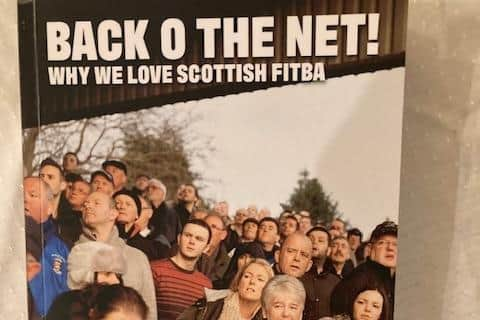Henry McLeish - my love of East Fife FC documented in former First Minister's new book
and live on Freeview channel 276
Much of my life has been wrapped up in the game……an entire world in a
football. If football means anything, it is about being rich in sentiment, emotion, nostalgia and brimming full of memories.
Advertisement
Hide AdAdvertisement
Hide AdAt every turn in football these thoughts have been there, sometimes in a small way, sometimes looming large. For me East Fife, my old club based in Methil, means a great deal.


Outsiders in the post-war period saw Methil as an unattractive place, but those of us who were born and brought up there are proud of it.
A once prosperous coal-loading port on the Firth of Forth, Methil was dominated by the local pits and unsightly bings.
Football and East Fife have played an important part in my personal story. For me it is about a sense of place, culture, identity, class, community, solidarity, and purpose.
Advertisement
Hide AdAdvertisement
Hide AdBorn in 1888, my grandfather Henry Cunningham Baird was my inspiration, and my love of football came from him. He played for East Fife between 1908 and 1913, when thousands of young men left – some never to return – to fight in the First World War. He was a remarkable man, spiritual and political.


I was privileged to have him as a grandfather. At the end of the war he returned home traumatised and took a while to recover before returning to work with the Wemyss Coal Company.
He became an evangelical Christian and being from Methil he was of course a socialist, a tireless activist and practised what he preached, especially during the Miner’s Strike in 1926.
So, my connection with the club had already been made before I first wore the black and gold jersey in 1964.
Advertisement
Hide AdAdvertisement
Hide AdIn recent times when visiting the new Bay View stadium, I feel emotional and proud to see the pictures of my grandfather and myself staring down from times past.
I am sure he would have had the same pride watching the East Fife team bus drive up to my high school to pick me up during classes to attend away games in the summer months.
I left Buckhaven High School in 1963 and signed for Leeds Utd FC when Don Revie was the manager. I couldn’t settle down, and on my return joined East Fife at the old Bayview Stadium and played my first game for the club against Queens Park at Hampden in 1964 when I was 16, the youngest player ever to play for them.
There were only 900 people in the stadium which could hold 130,000 at that time, but it was still an enormous thrill to be in the dressing rooms and out on that historic pitch.
Advertisement
Hide AdAdvertisement
Hide AdBut this is what is inspiring about the game: club achievement, history, pride, identity, commitment, loyalty, passion and often affection that trickles down the years.
You cannot measure these sentiments in goals or trophies, but they remain the emotional bonds that have carried many clubs from one century to the next: East Fife is part of that rich tapestry of Scottish football.
For East Fife, there is no shortage of success and achievements. My old club has had a remarkable history. East Fife won the Scottish League Cup three times in four years during the late 1940s early 50s and reached the final of the Scottish Cup in 1950 only to be beaten by Rangers.
A giant of that era was Charlie Fleming, known locally as “Legs” Fleming or “Cannonball” Charlie.
Advertisement
Hide AdAdvertisement
Hide AdHe had one of the hardest shots in Scottish football and played for East Fife between 1947 and 1955 before moving to Sunderland.
Still a legend today, he played for Scotland against Northern Ireland and scored twice. Remarkably that was his only appearance in the blue jersey of his country: I am sure that it had nothing to do with the west coast bias that dominated football in the early days of the game!
East Fife was one of only two clubs from the second tier of Scottish football ever to win the Scottish Cup, in 1937/38 season.
This astonishing Scottish Cup run attracted nearly 400,000 fans, with nearly 200,000 attending the final and replay against Kilmarnock at Hampden Park!
Advertisement
Hide AdAdvertisement
Hide AdUsing present day home game attendances at Bayview each season, East Fife would need 45 years to attract a comparable figure! How times have changed.
But this is what is inspiring about our game. Six special train loads of East Fife supporters were amongst the 97,710 fans at Hampden for the Wednesday night replay.
When I was a young player with East Fife, I had been selected to play a trial for Scotland’s under 18 professional youth team, which resulted in winning a cap for Scotland in an International youth tournament in the former Yugoslavia.
On our way to play Motherwell we dropped in to have tea in Paisley with John Sneddon, who was the club captain when they lifted the Scottish Cup at Hampden. The meeting was arranged by East Fife’s manager Jimmy Bonthrone.
Advertisement
Hide AdAdvertisement
Hide AdThe memories of Methil-born McLeish, 75, an author, academic and former professional footballer who served as First Minister of Scotland from 2000 to 2001, appear within the newly published book ‘Back O The Net! Why We Love Scottish Football’, compiled and edited by Paul Goodwin and Donald C Stewart.
Comment Guidelines
National World encourages reader discussion on our stories. User feedback, insights and back-and-forth exchanges add a rich layer of context to reporting. Please review our Community Guidelines before commenting.